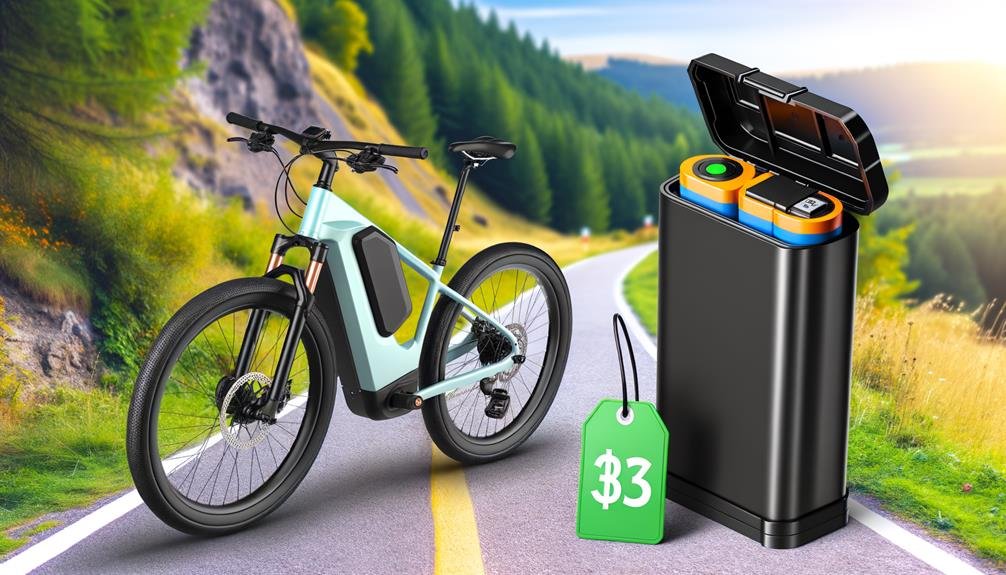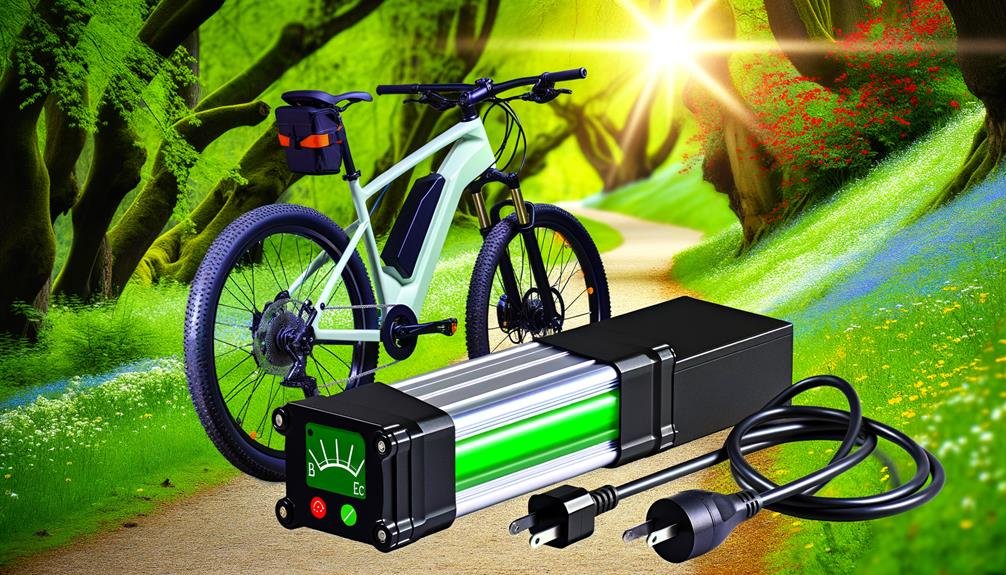Charles Miller is a veteran bike enthusiast with over 12 years of experience dealing with bikes as a mechanic. Despite immense love and expertise for...
The economic implications of owning an ebike are a significant consideration for many prospective and current owners. The cost of the battery often stands out as a primary concern. The price spectrum for ebike batteries can be broad and influenced by factors such as brand, quality, and capacity.
For instance, lower-end aftermarket options may start around $250, while official replacement batteries can command prices from $500 to $900. However, mere acknowledgment of these costs only scratches the surface of the financial aspects associated with ebike batteries.
To truly grasp the full economic picture, one must explore further aspects such as battery lifespan. The lifespan of an ebike battery can vary depending on factors like usage patterns, charging habits, and overall battery quality. Understanding how long a battery is expected to last is crucial when considering the long-term costs of owning an ebike.
Another important consideration is the impact of speed on battery life. Riding at higher speeds can drain the battery faster, reducing its overall lifespan. This means that owners who frequently ride at high speeds may need to replace their battery more frequently, adding to the overall cost of ownership.
Additionally, it is worth exploring cost-effective alternatives such as battery repair services. Instead of immediately purchasing a new battery when something goes wrong, some owners opt for repair services that can fix issues like damaged cells or faulty wiring. This can be a more affordable option compared to buying a brand new battery.
In summary, the economic implications of owning an ebike go beyond the initial cost of the battery. Factors such as battery lifespan, the impact of speed on battery life, and cost-effective alternatives like battery repair services all contribute to the overall financial considerations of owning an ebike.
- Key Takeaways
- Understanding Ebike Batteries
- Lifespan of Ebike Batteries
- Factors Influencing Battery Cost
- Impact of Speed on Battery Life
- Cost of Replacement Batteries
- Technical Elements: Volts, Amps, and Watts
- Upgrading to a Bigger Battery
- Tips for Recharging Batteries
- Maximizing Ebike Battery Performance
- Essential Battery Care Tips
- Frequently Asked Questions
- Conclusion
Key Takeaways
- Brand reputation and battery quality are important factors in determining the cost of ebike batteries.
- Official replacement batteries from renowned brands may be more expensive but offer better performance and longevity.
- Aftermarket batteries may be cheaper but can result in reduced performance and a shorter lifespan.
- Higher capacity batteries typically come at a higher price but provide extended range and improved performance.
Understanding Ebike Batteries
While the cost of ebike batteries is influenced by various factors such as brand reputation, battery quality, capacity, and individual requirements, it is crucial to understand the intricacies of these power sources to enhance their longevity and performance.
Lithium-ion batteries are commonly utilized in contemporary electric bikes. These batteries often employ cells in the 18650 format, although the number of cells used varies, largely depending on the manufacturer and design.
A key component in understanding ebike batteries is the Battery Management System (BMS). This system is pivotal in ensuring optimal performance, safety, and longevity of the battery. The BMS achieves this by maintaining balance, preventing overcharging, and regulating current flow.
Furthermore, companies like FTH Power provide more affordable options for battery replacement and repair services, offering an economic advantage.
Understanding the longevity and range of your ebike battery is also essential. Familiarizing yourself with factors affecting battery care and storage can significantly prolong the lifespan and performance of your battery. Therefore, investing time in comprehending the nuances of your ebike battery can result in not only substantial financial savings but also enhanced bike performance.
Lifespan of Ebike Batteries
Building on the understanding of ebike batteries, it is equally crucial to consider their lifespan, which varies considerably based on the type of the battery and usage patterns. The lifespan of ebike batteries can significantly impact the overall cost of owning and operating an ebike.
Lithium batteries, for instance, are known for their superior life cycle, providing an average of 1,000 cycles before needing replacement. This translates to roughly three years of use for the average user, assuming proper care of the battery. This extended battery life can often justify the higher upfront cost of lithium batteries.
In comparison, lead-acid batteries offer about 300 cycles and nickel batteries provide around 500 cycles, making them less cost-effective over time.
It's important to note that most eBikes can travel approximately 20 miles on a single charge, but this can vary based on factors such as terrain and rider weight.
Factors Influencing Battery Cost

Understanding the cost of ebike batteries necessitates a thorough examination of several key factors, including brand reputation, battery quality and capacity, and individual usage patterns.
Known brands often command higher prices for their E-bike Batteries due to their established reputation for quality and reliability.
The quality of the battery also plays a significant role in its cost. High-quality batteries, especially those with advanced Battery Management System (BMS), offer superior performance and longevity, which justifies their higher price. Lithium Battery types, for instance, are renowned for their exceptional performance and durability, making them a costlier but worthwhile investment.
Battery capacity, measured in watt-hours, directly affects the price. Batteries with higher capacities offer more power and range, making them more expensive than lower-capacity alternatives. Therefore, when considering a replacement battery, one must evaluate the trade-off between cost and capacity.
Lastly, individual usage patterns significantly influence battery cost. For frequent riders or those covering long distances, investing in a high-capacity, quality battery may prove more cost-effective in the long run. Therefore, while upfront costs can be daunting, the overall value delivered by the battery should be the primary consideration.
Impact of Speed on Battery Life
The relationship between speed and battery life of an ebike significantly influences its operational cost.
High-speed ebikes, while offering a quicker commute, may lead to a more rapid battery drain, thus escalating costs.
For optimal efficiency, a balance should be struck between speed and battery preservation, with considerations for the terrain and the rider's style as well.
Speed's Influence on Lifespan
It's crucial to note that the speed at which you ride your ebike significantly impacts the longevity of its battery. Higher speeds can increase energy consumption, leading to a faster drain on the e-bike battery. This consumption rate can decrease the overall lifespan of the e-bike battery.
Conversely, riding at moderate speeds is beneficial for preserving battery charge and prolonging battery life. This implies that the top speed at which you ride your e-bike correlates directly with its battery lifespan. Therefore, to enhance the longevity and cost-effectiveness of your e-bike battery, a moderate pace is advised.
The impact of speed on battery life underscores the importance of mindful riding for better battery longevity.
High-Speed Ebikes: Battery Drain
Building upon the previous discussion on the influence of speed on battery lifespan, we now focus on a specific category of e-bikes, namely high-speed e-bikes, and how speed variations impact their battery drain.
Operating at high speeds consistently results in a more rapid battery drain for your electric bike. This is due to the motor drawing more energy from the battery pack, particularly when you're pushing for those higher speeds. Consequently, the rate of charge consumption inside the battery increases, reducing the overall battery life.
To manage this, consider moderating your speeds. This will not only conserve your new battery's charge but also extend its lifespan, optimizing your high-speed ebike's battery drain and ensuring a longer, more efficient ride.
Balancing Speed and Efficiency
While maintaining high speeds on your ebike may offer an exhilarating ride, it inevitably leads to faster battery depletion due to the increased energy consumption. This effect is due to the physics of electric bicycles and the way the motor consumes power at higher speeds.
To balance speed and efficiency and ensure you're maximizing your battery life, consider these factors:
- Moderate your speed: Riding at excessively high speeds drains the battery faster. A more moderate pace extends battery life.
- Maintain a consistent speed: Speed fluctuations can impact battery efficiency.
- Understand your ebike's optimal speed: Each ebike has an optimal speed for battery efficiency. Familiarize yourself with this to optimize your rides.
Cost of Replacement Batteries
Replacement batteries for ebikes vary significantly in cost, influenced by factors such as brand reputation, battery capacity, and technological advancements.
For instance, higher capacity batteries like the HIPEAK Removable 48V 15Ah Lithium Battery, which extends the length of trips, are priced at $399.00.
On the other hand, repair services such as FTH Power offer a more cost-effective solution at around $300.
It's crucial to weigh these factors and consider the balance between cost and quality when choosing a replacement battery.
Comparing Battery Price Ranges
Diving into the diverse price ranges of ebike batteries, it's evident that costs can vary significantly. Official replacement packs typically fall between $500 and $900. These batteries are specifically designed for electric bikes and offer reliable performance, which justifies their higher price tag.
FTH Power offers a repair service for around $300, plus a $35 service fee for testing the pack. This option can be more budget-friendly, but it's important to consider the potential impact on performance and longevity.
Aftermarket batteries are another option, which can be found at approximately $250. However, it's important to note that the quality of these batteries may not match that of official replacements. This can result in reduced performance and a shorter lifespan.
On the other hand, manufacturer batteries are often more expensive but provide superior performance and longevity. These batteries are specifically designed for the ebike model and are optimized to deliver the best possible results.
Factors Affecting Battery Cost
Understanding the cost dynamics of ebike batteries necessitates a comprehensive look at various influencing factors.
One of the most significant factors is brand reputation. Renowned brands usually offer high-quality batteries that guarantee longevity and stellar performance. However, these batteries also come with a higher price tag.
Battery capacity is another important data point that directly influences cost. Battery capacity is measured in watt-hours, and higher capacity batteries providing greater power and range often come with a heftier price tag.
Individual requirements and usage patterns also play a pivotal role in determining the overall cost of ebike batteries. Different users have different needs, and their usage patterns can impact how quickly they go through battery power.
Choosing Quality Over Price
While considering these key cost factors is vital, it becomes equally important to evaluate the quality versus price equation when selecting a replacement ebike battery. It's crucial to remember that not all batteries are created equal, and oftentimes, a lower price can indicate inferior quality.
High-quality batteries from reputable brands might cost more upfront but offer better longevity and performance, ensuring you get the most out of your investment.
A battery with a higher capacity (watt-hours) might demand a higher price, but it provides a greater range, enabling longer rides.
Advanced battery technologies, while more costly, offer higher energy density and faster charging rates, optimizing your ebike experience.
In essence, prioritize compatibility, reliability, and performance when choosing a replacement battery. The initial cost should be secondary to these key considerations.
Technical Elements: Volts, Amps, and Watts
In the realm of ebike technology, three key elements – volts, amps, and watts – play crucial roles in defining the power output, energy transfer rate, and overall performance of the ebike system.
Volts are responsible for driving electricity through a circuit, thereby directly impacting the power output and speed of your ebike. The greater the voltage, the more potent the power, enhancing the riding experience through increased speed and torque.
On the other hand, amps signify the amount of electrical charge flowing per second, thus determining the rate of energy transfer and the performance of the ebike's motor. Higher amp ratings can ensure a more robust and sustained performance, which is particularly beneficial for longer journeys or when tackling challenging terrains.
Lastly, watts define the workload of the ebike system and can be calculated by multiplying volts by amps. This figure provides a straightforward representation of total power consumption, allowing riders to better understand and manage their energy usage. Moreover, watt-hours, derived from volts and amp-hours, offer an estimate of the ebike battery's range, assisting users in gauging the potential distance they can cover on a single charge.
Upgrading to a Bigger Battery

When considering upgrading to a larger eBike battery, several factors will influence the cost.
Firstly, the size and range of the battery will directly impact the price – bigger batteries with a longer range typically cost more.
However, it's crucial to balance these factors with your individual needs and usage patterns to ensure you're making a cost-effective decision.
Cost Factors of Upgrades
Often, upgrading to a larger capacity ebike battery can lead to an increase in cost due to the enhanced range and performance it provides. The size and capacity of the battery, directly affecting the range and speed of the ebike, are key factors in determining the price.
Here are some elements to consider:
- The battery's position on the bike, such as a Rear Rack, could impact the overall cost of the upgrade.
- The brand reputation and quality of the battery also play a significant role. Renowned brands tend to cost more due to their established trust and proven product quality.
- Special features like faster charging rates or high energy density can also increase the price.
Understanding these factors can aid in making an informed decision when considering an upgrade.
Battery Size and Range
Having examined the cost implications of upgrading an ebike battery, it is essential to explore the impact of the battery size and range on the overall performance of the bike.
A larger battery can significantly improve your bike's range, allowing you to embark on longer rides around town without worrying about recharging. Essentially, a bigger battery offers more watt-hours (Wh), translating to more power and longer distances covered.
However, it's important to note that battery size and range are also influenced by factors like terrain, rider weight, and riding style. Therefore, when planning an upgrade, it's vital to consider not only the increased cost but also the potential benefits in terms of extended range, improved performance, and enhanced riding experience.
Tips for Recharging Batteries
Properly recharging your ebike battery can significantly enhance its lifespan, and several strategies can be employed to achieve this. To make sure you get the most out of your battery, it's crucial to follow a few key practices that will help maintain its health and longevity.
Firstly, try not to charge your battery to its full capacity. It's often recommended to charge the battery only up to 80% to extend its lifespan. Overcharging can cause the battery to degrade faster.
Secondly, avoid leaving the battery on the charger for an extended period. This can cause the battery to overheat, leading to potential damage and reduced battery life. Make sure to unplug it once it's sufficiently charged.
Lastly, if you're storing the battery for an extended period, such as during the off-season, ensure it has at least 40% charge. This helps prevent the battery from reaching a state where it can no longer hold a charge.
Taking care of your ebike battery by following these tips can not only prolong its life but also ensure your rides are hassle-free and enjoyable.
Be sure to regularly check and follow the manufacturer's guidelines for battery care and maintenance.
Maximizing Ebike Battery Performance

While adhering to these charging and storage guidelines is crucial for maintaining your ebike battery's health, it's equally important to consider strategies for maximizing its performance. The first step is to choose a high-quality battery from a reputable brand. This not only ensures better performance, but also significantly improves the longevity of your battery.
Taking into account battery capacity and your individual usage patterns is also essential in maximizing power and range according to your needs. This means understanding the watt-hour of your battery and how it corresponds to your daily usage.
Staying updated on battery technology developments is another strategy to enhance performance. Advancements in energy density and charging rates can dramatically improve your ebike's performance.
Battery maintenance is a critical aspect of maximizing performance. This includes avoiding complete discharge, extreme temperatures, and overcharging, all of which can affect the battery's lifespan and performance negatively.
Essential Battery Care Tips
In the quest for optimal eBike performance, a cyclist's attention to essential battery care practices plays an instrumental role. Proper battery maintenance is not just about preserving the eBike battery's lifespan, but it is also about ensuring that the battery delivers its maximum potential every time. Proper care and attention can prevent unnecessary wear and tear, helping you avoid the costs associated with premature battery replacement.
Here are a few important tips to keep in mind:
- Avoid charging the battery to 100%. This can help to prolong its lifespan.
- Store the battery with at least 40% charge during off-seasons to prevent damage.
- Prevent complete discharge for extended periods and avoid leaving the battery on the charger for too long.
Frequently Asked Questions
How Long Does an Ebike Battery Last?
An ebike battery's lifespan varies based on its type. A lithium battery can last for approximately 1,000 cycles, translating to around three years. Proper lifecycle analysis and care can maximize longevity, ensuring optimal performance.
How Much Does It Cost to Replace a Bike Battery?
The expense to replace an e-bike battery varies significantly based on factors like brand, quality, and capacity. Considering recycling options might reduce costs. Consultation with reputable manufacturers or e-bike shops can provide more accurate estimates.
Can You Buy a New Battery for an Electric Bike?
Yes, you can purchase new batteries for electric bikes. Battery upgrades are available to enhance your ebike's performance. It's recommended to consult with experts to ensure the battery is compatible and meets your specific needs.
How Much Does It Cost to Fully Charge an Ebike?
Like fueling a traditional vehicle, the cost of fully charging an Ebike depends on the battery's capacity and charging efficiency. Typically, it's relatively economical, averaging around 10-20 cents per charge based on electricity rates.
Conclusion
In conclusion, the cost of an ebike battery is influenced by several factors including brand reputation, battery quality, and capacity. Prices can range from $250 to $900, with higher-quality and larger-capacity batteries being more costly.
Thorough research and consultation with reputable e-bike shops or manufacturers is recommended. Utilizing battery repair services, such as those offered by FTH Power, can provide a cost-effective alternative to buying a new battery.

Charles Miller is a veteran bike enthusiast with over 12 years of experience dealing with bikes as a mechanic. Despite immense love and expertise for his Tacoma, he rides his Trek Ebike more. Anytime you meet him, you’ll either hear him talking about Bikes, or writing about all things bikes and cars on this blog.
More Posts


